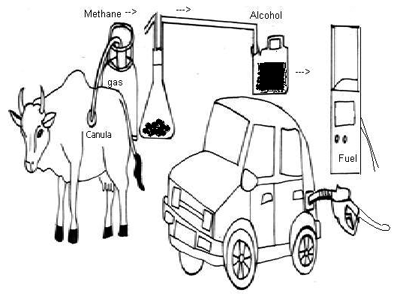Dr. Hari Mohan Saxena submits the research program below. Dr. Saxena is Professor cum Head, Department of Veterinary Microbiology, College of Veterinary Science, GADVASU, Ludhiana India. The drawing is by his daughter, Priyanka Saxena.

Dr. Saxena writes:
***
The cow is worshipped in India because it gives milk to nourish the body. However, there is one reason to worship even the dry, unproductive cow as it could be a wonderful source of fuel to run your car. The ruminants like cattle and buffaloes are known to produce methane through the degradation of feed by methanogenic bacteria present in their rumen. The emission of methane by the bovines has even been claimed to contribute to the green house effect and hence to the global warming. However, this metabolic capability of the cow can be exploited to human advantage by collecting the methane by canulation of rumen. The methane can be accumulated and stored in cylinders and can later be converted into alcohol which can be used as a fuel additive or a fuel substitute. The technology of converting methane into alcohol is known and is already in commercial use.
The canulation of rumen is not difficult and is used by animal physiologists to study the rumen physiology. Once the canula is in place, its opening can be connected with a tube for collecting the gas. The tube can be detached from the canula and the opening of the canula can be easily closed when required. The process of canulation of rumen is not required to be repeated again. Once the canula is in place, it does not cause any pain or suffering to the animal. Cannulated cows are similar to any other cow with one exception – they are fitted with a canula, or a small window. The process doesn’t really hurt the cows. A canula is placed on a cow through a surgery done when it is two to three years old. The cow is anesthetized during the surgery, so it doesn’t experience any pain. Cannulating cows doesn’t affect their ability to function as a normal cow. Their digestive systems are not inhibited in any way.
This idea would be useful for making the use of stray unproductive animals and particularly the male cattle and buffaloes which are not permitted to be slaughtered in India on religious grounds and are currently being reared and fed at free animal shelters by religious people and charitable organizations without any economic benefit.